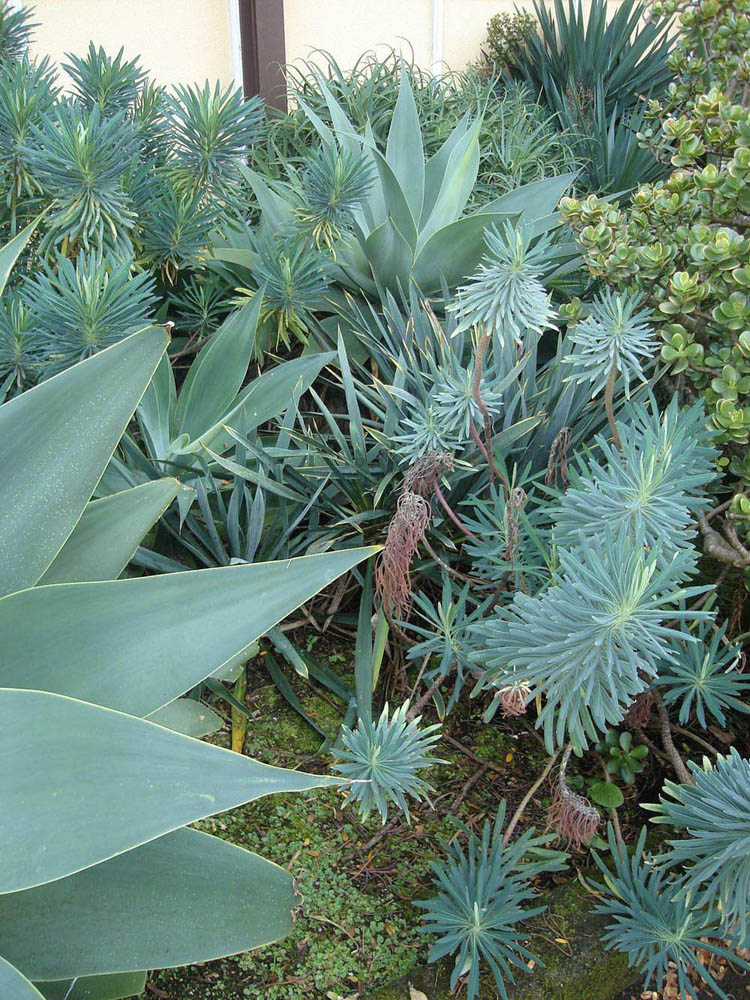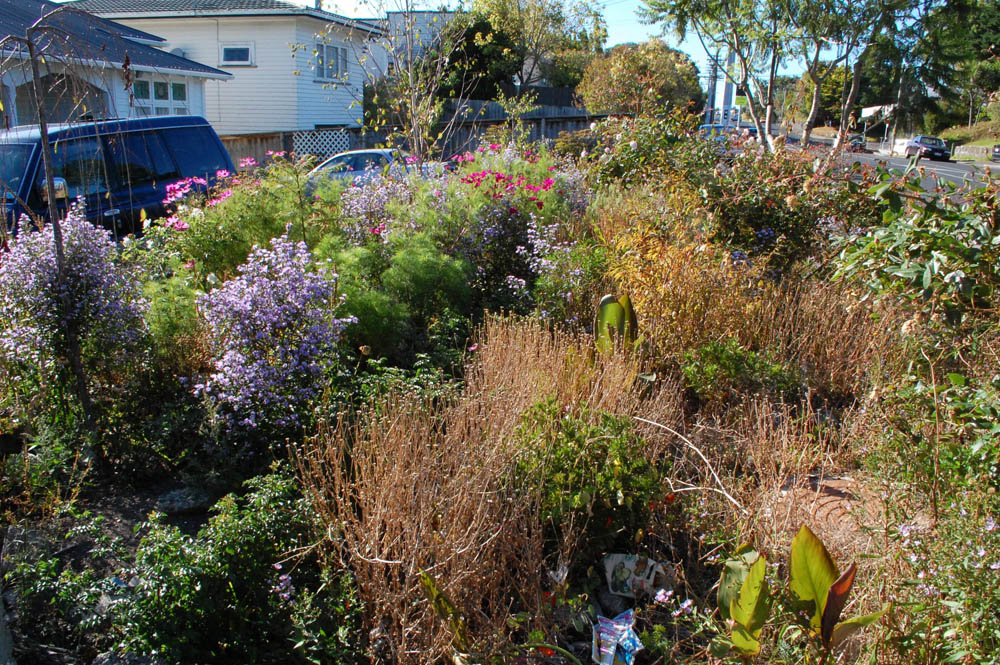Does natural = native? Does native = natural? by Nick Robinson
This is the second of a new series of short pieces for landscapedesign.co.nz in which I look at current trends and ideas in garden design.
We live in a biodiversity hotspot (to find out more about what make this the case see the Conservation International website and especially here. What makes us so important to global biodiversity is of course the range of native flora and fauna found nowhere else, and the fact that this unique New Zealand plant and animal life is at risk from loss of the habitats and damage to those that survive.
So we need to take great care of our special plants and animals, partly by protecting the places where they grow. But gardens and gardeners are also a valuable part of that conservation effort: many of our rarer plants are now common in gardens and public plantings. The three kings vine is probably the rarest plant in the wild in the world – only one plant has ever been discovered in the wild, growing on one of the Three Kings islands, but this species is now a common climber on fences and trellises in gardens. We still need to protect it in the would but it is important to know that at least the plant’s genes are safe in the gardens of New Zealand. Another example is the blue shore spurge, Euphorbia glauca – less immediately endangered but still in need of conservation effort. This is also popular in gardens, not least because of its distinctive foliage qualities and colour. The photo below is a stunning example of how combining this plant with other striking blue foliage specimens brings out the very best in its aesthetic colour and textural qualities.

Caption: The rare native Euphorbia glauca combines superbly in a colour and texture inspired assemblage including Agave attenuata, Crassula ovata (Jade plant), Yucca species and others.
This is a classic example of the effective horticultural use of our native plants in combination with popular exotic garden and landscape species and varieties. Although it may look rather different in visual character, the next photo also shows a horticultural use of natives. This is a lovely bit of planting at Fern Glen Garden in Birkenhead, Auckland, a native plant collection. This composition does not include any exotic species but, with its careful arrangement of species from different habitats it is, in that way, just as artificial as the Euphorbia, Agave and Crassula.

Caption: Planting at Fern Glen Garden: alpine hebe species, the threatened forest grass Anementele lessoniana, Olearia and the swamp loving Phormium tenax make a well composed assemblage. This is good for plant conservation – but is it a “natural” association?.
This crafted planting helps to conserve the gossamer grass – another threatened New Zealand plant but cannot be said to be ‘natural’ because it is artfully contrived and because these plants would be very unlikely to be found together in ‘the wild’. So is it really so different to the use of natives in gardens along with exotics?
This answers the first part of my title question – native does not, necessarily, = natural. Now for the second: can we be natural without being native? You might be wondering what exactly is the point of these distinctions – perhaps they are a bit academic but the idea I want to convey is that when we are looking for naturalness and wildlife habitat in urban landscape and gardens the answer does not always come in the shape of New Zealand natives. In fact I am going to argue that one of the best way to use them is to mix natives and exotics in a new naturalistic way to create a garden buzzing with insects and melodious with birdsong. Is this heresy? Tell me what you think.
We know how the tuis and other nectar feeding birds love many of the exotic trees like silk oak (Grevillea robusta), banksias and gums like the winter flowering Eucalyptus leucoxylon ‘Rosea’ Exotics, even weeds, can actually be valuable for wildlife too, especially the bees and other pollinating insects that are so essential for our gardens and food production. Bees are currently suffering alarming decline worldwide, including New Zealand and need as much pesticide free food plants as we can provide. Bees and other pollinators love nectar and pollen-rich flowering trees such the red gum Eucalyptus ficifolia, the willows in early spring, and even Hakeas, as well as many herbaceous flowers including echinaceas, asters, cosmos, foxgloves, persicarias and so planting these provides much needed food and shelter for this valuable wildlife.
Gardens full of exotic flowers can be so rich in biodiversity that a Sheffield University research project in the UK found that urban gardens could host a greater diversity of plant and animal species by area than some national nature reserves.
Perhaps surprisingly, these kinds of plants can perhaps be successfully combined with NZ natives as long as we are careful to match growth habits and aesthetic character. A recent garden in Te Atatua, Auckland by Philip Smith of O2 landscapes and another in Westmere both illustrate an innovative approach to combining rare natives with exotic plants, for colour interest and habitat value.

Caption: An Auckland garden by Philip Smith of O2 landscapes. This planting at the top of a limestone wall includes unusual natives such as Melicytus obovatus, Melicope simplex and Hibiscus richardsonii plus the deep maroon flowered South African Pelargonium sidoides and white-flowered form of Tulbaghia fragrans,
This Westemere garden is a lovely example of restrained design using refined plants but the more exuberant exotics can also be successful in very natural looking plantings. Consider figure 4: an apparently random collection of weedy wild flowers – mostly, but not entirely, exotic which have formed their own meadow-like pant community in the front garden of an Auckland garden. And indeed ventured out to replace the typical close-mown and spray-edged berm with a bio-diverse, colourful very low maintenance paradise for pollinators – It was a-buzz with bees and other insects when I took these photos. These plants are vigorous and ecologically well balanced, so very little cutting back or dividing is needed and a few weeds do not detract from its beauty. Could more of this type of planting be an alternative to hectares of mown grass and hectares of woodchip? I think so.

Caption: A semi spontaneous, naturalistic meadow of perennials plus a few shrubs and trees. This includes asters, cannas, feverfew, cosmos, shasta daisy, stachys and a number of other daisy family perennials. This occupies not only the front section but also the road berm and offers a great delight to all passers-by.
I will take a closer look at ways of creating flower-rich lawns and diverse urban grassland in a future article. Lawns full of bee friendly and beautiful flowers are very suitable for our climate and ecosystems.
 Nick Robinson, landscape architecture + garden design
Nick Robinson, landscape architecture + garden design
Nick has twenty years’ plus experience of landscape architecture professional practice in New Zealand and Britain. Before setting up his own practice he worked on significant landscape projects across the North of England as a Landscape Architect for Arnold Weddle, for Rotherham Metropolitan Council, and as Design Principal for ECUS, the Environmental Consultancy of the University of Sheffield. This work included a number of award winning landscapes of industry, new roads, campuses, urban regeneration and parks. Nick has worked for over 10 years in New Zealand, gaining broad experience of landscape design in the varied natural and cultural landscapes of the South Pacific.
In addition to professional practice, Nick has taught landscape architecture at universities in the UK (Sheffield and Gloucestershire), USA (Cal Poly) and New Zealand (Lincoln and UNITEC) and has a range of publications to his credit including the Planting Design Handbook (now in its revised second edition) and journal articles. He has recently completed a sabbatical period working and studying at the Department of Landscape, University of Sheffield, UK, with a focus on current thinking on ecological approaches to urban design and innovations in planting design for biodiversity, and working with international experts on urban ecology, green roofs and green walls.


